| JAMES SHIRLEY'S TRIUMPH OF PEACE:
ANALYZING GREG'S NIGHTMARE
by
STEPHEN TABOR
| ||
§8. Quire D and "A Speech"
Readers who have followed me to this point will, I trust, agree that the
thirty-six
pages of The Triumph of Peace comprise a Wunderkammer of bibliographical
problems, any one of which
could support a separate study. The last quire will
not disappoint.

A. QUIRE D PHASES I-II
Quire D begins life with an outer forme showing an orderly progression
of
variants:
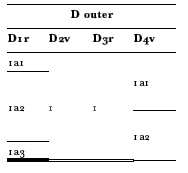 |
The second state of D1r supplies a missing word; at the same time the first
three
lines lose their horizontal alignment. This state gives way to a third one
in
which the same three lines of type are damaged. D4v shows a more subtle
change, in
which the right parenthesis of the page number suffers damage near
the bottom;
this occurs while D1r is in its second state.
The inner forme on this set of sheets also shows a regular progression, but
with
a clear work stoppage indicating two phases:
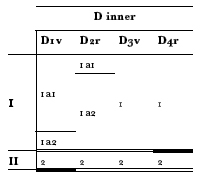 |
The variants are
D1v: State 1a1 has a comma that has slipped into the line below, and a
damaged
parentheses to the right of the page number. In state 1a2, the comma
is
correctly positioned and the parenthesis is sound. This sequence, which
could
have gone in the opposite direction, is confirmed by

D2r: The second state (1a2) corrects a typo, improves sense by adding a
comma,
and pushes down one of two quads that were printing inappropriately
in the first
state.
The conspicuously damaged parenthesis in D1v:1a1 is the same one found on
C2v,
also in Phase I, in the same position to the right of the page number and in
the
same quarter of the forme. This recurrence gives us a clue about the order
of
printing these quires in Phase I. There are two possibilities:
- Quire D came first. The damaged parenthesis was removed
part-way
through Phase I as one of five stop-press improvements to the inner forme, but
instead of being discarded it was put back in the type-case and later set—coincidentally
in the same position—in the headline of C2v. - Quire C came first. After Phase I of that quire the damaged
parenthesis
either persisted on D(i) as part of the skeleton, or returned to
the type-case to be set—coincidentally in the same position—on D1v. In either case, part way
through Phase I of quire D, its damaged state caught the eye of the corrector
and it was discarded.
The second possibility—that the parenthesis remained as part of the skeleton
and
was later replaced by a sound type—is much more likely; and indeed this
damaged
parenthesis never reappears in later states of ToP.
The independent typographic evidence that Phase II of the inner forme
followed
Phase I is rather slight: the correction of one error in line 8 of D3v,
which
kept the same setting of the first twenty-one lines from Phase I. However,
as most
copies of ToP containing Phase II also contain
later states of quires A-C, we can
be confident of this direction of change.
When we put together Phases I and II of the two formes of D, their
relationship
becomes complicated:
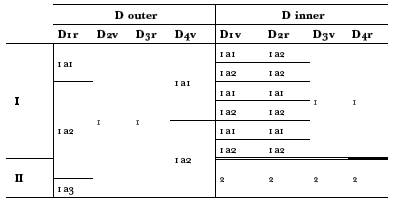 |
This table shows two oddities beyond the fault-lines indicating the pauses
in
production, which by now we have become accustomed to:
- There were two production phases of the inner forme, marked by
skeleton
changes on three pages (D1v, D2r, and D3v) and a complete resetting of D4r.148However, the outer forme of the same sheets appears to be the product of one
continuous printing, with states 1a2 and 1a3 each appearing within Phases I or II,
not during a pause between them. - Phase I of this quire shows an illogical mixing of states between the
two
formes. If we consider only the states in this phase and ignore the invariant pages,
the scheme looks like this:
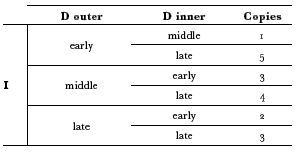 |
This is very nearly a random shuffling; like the permutations of quire C in
Phase
I, it cannot be attributed to any plausible method of flipping a single stack.
The
three combinations that do not occur are early/early,
middle/middle, and
late/middle; but there is no guarantee that these would not
emerge if new copies
of the book were to come to light. As with quire C, I am
unable to explain the
distribution of variants here.
Point 1 above—the fact that the inner forme goes through two production
phases
while the outer forme appears to have only one—is easier to explain if
we suppose
that the outer forme went through two printings with no alteration
during the
pause between them. Phase II of D(i) associates mostly with the third
state of the
outer forme (D1r:1a3), in which the first three lines of type on D1r
show damage.
The accident that caused this may in fact have come in the transition
to Phase II.
The distribution of surviving copies is as follows:
 |
Only two copies (McMaster University, and British Library Ashley
1697,
shaded above) show sheet D with its inner forme from Phase II
but the outer
forme in the undamaged state typical of Phase I.
28
If we take the hypothesis that

the inner forme, there are at least two possible explanations for the observed
distribution:
- The damage occurred early in the second printing of D(o), or
- McMaster and Ashley 1697 represents a small residue of
sheets which for
some reason were not perfected during Phase I. The damage occurred during
the replacement of the outer forme in preparation for Phase II. The Phase II
sheets with the damaged type were combined with the Phase I leftovers and
perfected with Phase II of the inner forme.
It is more likely for damage to occur at points of transition than during
periods
of repetitive work, so I lean toward the second explanation. Either one
requires
some special pleading to fit the hybrid copies into a plausible narrative.
There
is no doubt, though, that they are closely associated with the skeleton
change in
D(i), which marks the end of Phase I of that forme, and the same phase
also
produced about equal numbers of quires A-C.
Before Phase II came the pause during which italic was raided in quires A
and C.
Norton raided quire D as well, but only the inner forme. Three of its
constituent
pages show the italic in a new setting in Phase II, while the
fourth
page—consisting almost entirely of italic—was entirely reset. D3r, in the
outer
forme, could have supplied a good amount of the font but was not
touched.
For Phase II of quire D, Norton printed the outer forme, as I have
argued,
unchanged from its Phase I state except for the damage to D1r (which could
also
have happened early in Phase II). Following Phase II, another small italic
raid
occurred on both formes, carrying off the songs on D2r and D3r. The former
leaf
had already been raided, even more extensively, following Phase I. The
second
raid shows a continuing need for the font beyond its earlier use to set the
dedication
for ToP; some other job was interrupting at this
point. Concurrently with
these replacements, and quite bafflingly, the roman
portion of D3v—about two
thirds of the page—was reset. I cannot begin to suggest a
reason for this.
B.QUIRE D PHASES III-IV
Uniquely for ToP, Phases III and IV of quire D contain two
different settings
that mix randomly in copies containing Phases III and IV of the
other quires. I
will call these settings A and B:
 |

Setting A, in six out of the eight pages of the quire, is simply a reimposition
of
the standing type from Phase II; the first two pages are reset. Setting B
contains
typographic features not found elsewhere in ToP,
nor in any of Norton's printing
from the years 1633–34 that I have
seen. The characteristics are:
| Quire D, setting B | Rest of ToP (Norton) | ||
| k | The diagonal arms are stunted, the upper-right serif failing to reach the x-height and sometimes tilted upward. | k | The upper diagonal arm consistently reaches the x-height. |
| w | In some examples, the left V meets the right one a bit downward from the middle serif; the bottom of the left V falls below the baseline of the right one, so that the letter usually appears to tilt to the left. | W | The left and right V's meet the middle serif at the same height, and the letter does not tilt. |
| h | The curvature of the legs is midway between that of Norton's i-1 and i-2; the right leg ends pointing left. | h | In i-1 the legs curve slightly toward each other but do not approach closure; the right leg ends pointing 45 degrees below horizontal. In i-2, they close almost completely; the right leg ends pointing straight left. |
| 3 | Full-bodied. | 3 | Abnormally narrow. |
| o | Ranges with the other lowercase letters. | o | Usually too large. |


These are strong tendencies, not invariable markers, but the differences
are
pronounced enough to indicate that a second printer's type was used in
setting
B. The immediate suspicion falls on Nicholas Okes, with whom Norton at
this
time had an informal and increasingly fractious partnership.
29
Okes had already

his 1609 stock as catalogued by Peter Blayney 30 —Norton is known to have filched
other woodcut material during their association. To confirm my hunch about
Okes, I surveyed English books printed in 1633–34, searching for the odd "k"
and "W" in particular. Unsurprisingly, this did not yield an unequivocal answer.
Early-modern printers' typographic stocks were not proprietary, homogeneous,
or static, and there are no woodcut elements in quire D to help finger the collaborator.
I found versions of the stunted "k" in the repertoire of numerous
printers, including at the university towns, and "W" showed great variability in
most samples. Many texts I looked at did not even contain english-size type—
the smaller pica is much more common—and a good proportion were Latin, in
which letters "W" and "k" are rare. My search for definite fingerprints became
an exercise in probabilities, trying to estimate frequencies of the characteristic
sorts in scattered pools of the target font. In the end, though, my survey supported
Nicholas Okes as the most likely owner of the type used in quire D setting
B. 31 A hardier investigator than I might be able to clinch the identity with
a survey of broken types in Okes' other productions, but for narrative simplicity
in this account I will treat it as a certainty.
Though Okes' type may appear in setting B, we cannot assume that he had
personal
responsibility for the printing. A series of undated petitions beginning in
late
1635 shows a deteriorating relationship with his partner. Okes' most
interesting
complaint is that Norton, "wanting Capacitie himself for the
Government
of a presse hath enterteined ayded & assisted a Company of
disorderlie & factious
persons for the erecting of an unlawfull presse in a
secrett place, and hath
without [my] knowledge & Consent ... secretly conveyed
out of [my] house [my]
formes and lettres which afterwardes were discovered and
seized by the master
& wardens of the Company of Stacioners & at their
hall melted and defaced to
[my] great disgrace and losse."
32
The chronology of these events is vague,
but
another document, dated January 1635, reinforces the impression
that both men
were accustomed to playing fast and loose in their business. This
list, endorsed
by Sir John Lambe of the High Commission,
claims that the two printers jointly
employed, in addition to five authorized
apprentices, six individuals "brought
upp to Printing against order".
33
The latter group, which included a
butcher,
a gingerbread maker, and a garbler, may have constituted the "disorderly
and
factious" team that Norton recruited to run his clandestine press. There is
no
evidence that the "Okes" ToP quire D was printed
off-site, or even that Norton

operated in the shadows, and we cannot take for granted the ostensible paternity
of any of their productions.
Okes' setting of quire D occurs in seven of the seventeen surviving copies
of
Phase III and in four of the nine copies of Phase IV Possibly Norton and
Okes
each printed about equal numbers of sheets to supply the last two phases, or
Okes
printed rather fewer. I have not found any variants in Okes' sheets. Although
the
typesetting is not error-free, one gets the impression of a more assured
compositorial
hand than Norton's crew could muster. It is not clear why Norton
brought in
a second printer at this late stage to run off a "duplicate" setting of
the quire. In
§16, I will show that the time gained by running the same eight
pages of text on
two presses was nearly offset by the time taken in setting them
anew. The complications
of using a clandestine off-site press would further reduce
or even negate
the advantage. This consideration, along with the greater
professionalism of
Okes' quire D setting, argues against Norton's direct agency in
its production.
We know that Phases III and IV of sheets A-C contain multiple impressions,
so we
would expect sheet D to show evidence of this as well during Okes'
involvement.
However, as mentioned, Okes' sheets contain no variants that I
have
identified. Norton's sheets for Phases III-IV are also virtually identical,
but D1r
shows some interesting small changes:
2a1: l. 10 has "Masqncrs"; signature mark under the "hi" of "white,"
2a2: l. 10 has "Masquers"; signature mark under the comma of "white,"
2a3: l. 10 has "Masquers"; signature mark under the "w" of "white,"
From the spelling correction it appears that states 2a2 and 2a3 follow 2a1.
The
shifts in the direction line raise the spectre of reimposition. However, the
signature
mark—anomalously, an italic "D"—appears to be the same type in all three
states.
(Transient bits of foreign matter appear either as specks within the
letter [mostly
in 2a2] or falling across one or the other serif.) The page number
also appears
invariant in composition and position. It would be tempting to
attribute the states
of the direction line to random shifts due to loose lockup,
except that there are n
ointermediate states, and the variants tend to sort in a
complex but fairly orderly
fashion with sheets of the other quires. Norton's
states of sheet D show the following
distribution:
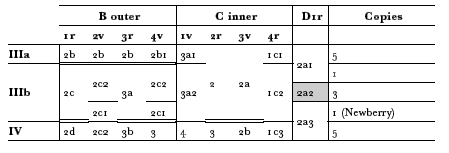 |

The table shows that state D1r:2a1 is found only with Phase-III copies of
the
other quires, while 2a3 associates (with a single exception) with Phase-IV
copies.
State 2a2 (shaded) is transitional between 2a1 and 2a3, and it occurs in
copies
having B(o) from Phase IIIb. Those same copies have unique states of pages
in
the inner forme of sheet C. In §11–14, I will return to these links among
the
three quires. For now, it appears that the D sheets containing Norton's
D1r:2a3
could represent a discrete Phase IV, his final one for that quire. The
"leakage" of
2a3 into Phase III, represented by the Newberry copy, could have
resulted from
Norton's having printed sheet D a bit short in phase III. Thus, a
small group of
Phase-III copies of the book may have been made up with Phase-IV
sheets of
quire D. Those hybrids probably went to the warehouse along with the
purebred
Phase-IV copies.
If we accept that Norton printed Phases III and IV of quire D as
distinct
impressions, what about Okes? Might he have printed all his sheets for
both
phases in one go? If we allow this possibility, we have to explain the fact
that, in
the surviving copies, Okes' contribution makes up about an equal
proportion in
each phase: respectively 41 and 44%. When, after Phase III, a
workman began
collating complete copies, he would probably start picking D-sheets
from a homogeneous
batch of one or the other man's production, whichever came to
hand
first. This process would almost certainly produce different Norton/Okes
ratios
in Phases III and IV So, either the D sheets after Phase III already
contained
about 40% of Okes' work, or Norton deliberately manipulated the ratio to
equal
that in the upcoming Phase IV. Such an intervention supposes obscure
motives
and more fastidiousness than I can credit Norton with. The same objection
applies
to a hypothesis that both men printed their sheets for Phases III and
IV
in a continuous run. The more plausible explanation is that Norton brought
in
Okes to print a half-share of Phase III sheets, but asked him to keep the
eight
pages in type, skeletons intact, against a probable fourth printing. When
that
need came about, Okes was able quickly to reimpose the pages without
alteration
for the new run. This scenario asks a high degree of precision from
Okes, and
requires that he tie up eight pages of type without knowing for certain
whether
they would be needed—otherwise, why not go ahead and print Phases III
and
IV together? I cannot give a detailed and definitive account of Okes' work
cycle.
It is intertwined with the mystery of why he got involved at all; if we
knew the
answer to one, the other would probably follow. However, I favor the
theory
that Norton's and Okes' teams worked in tandem on Phase III of quire D,
and
that—on the slim evidence of surviving copies—each produced an
approximately
equal number of sheets, of which Norton's contained states D1r:2a1
and
the much less common 2a2. Once they reached the end of Phase III, the
pages
of type from both printers' pairs of formes were tied up and there was a
pause,
during which completed copies from Phase III were assembled and
dispatched.
After an indeterminate time came Phase IV, for which both printers
again machined
approximately equal runs of their respective settings of quire D.
Norton's
sheets of these final copies differ from those of Phase III only in the
position of
the signature mark on D1r, which moved about three millimeters,
probably during
the reimposition process, producing state 2a3 of that page.


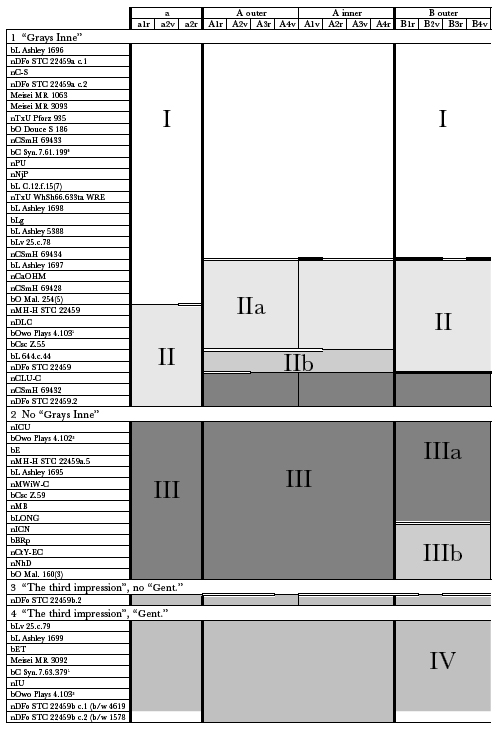 |
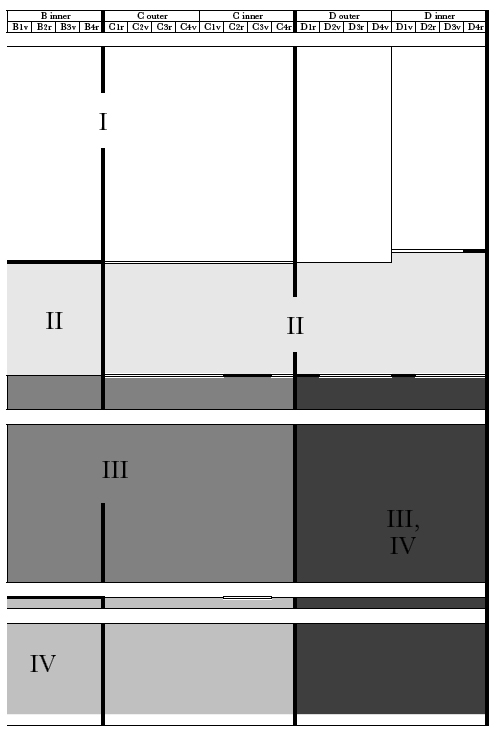 |

Norton and Okes seemed to feel that a further impression would be called
for
after Phase III, but something prevented them from going on to print a
double
run of quire D. The publisher Cooke may have been uncertain about
demand.
But Phase IV also ushers in the bulk of the substantive textual variants
in ToP
These occur in the description of the procession on
A2r and A3r, in the tavern
direction on B3r, and in antimasques on C1v and C2r.
None of the variants are
stylistic; they seem rather to document actual changes in
the performance. By the
end of Phase III, Norton and Okes may have known that
revisions were coming.
Although, in the event, none of these fell in quire D, the
printers may not have
known this, and therefore put the type-pages for the last
quire aside until the
matter was settled.
The singleton epilogue leaf "A speech to the King and Queenes Maiesties",
found
in only four copies (and Greg's own copy, now untraced),
34
exists in a single
state, printed by Norton using
mostly his workhorse italic i-1. The page is headed
by the now-familiar motif of a
double row of acorns (28 pairs in this case). I will
consider the history and
status of this addendum in succeeding sections.
Alan B. Farmer, "John Norton and the Politics of Shakespeare's
History Plays in
Caroline England", in Shakespeare's Stationers (ed. Marta
Straznicky, Philadelphia: University of
Pennsylvania Press, 2013),
pp. 147–176; Peter Blayney, The Texts
of King Lear and their Origins
(Cambridge: Cambridge University Press,
1982), pp. 304–313; C. William Miller, "A
London
Ornament Stock: 1598–1683
(Studies in Bibliography, 7 [1955], 125–151
[131–136].
Blayney, op. cit., p. 445, factotum 1 (rotated
180°). An apparently early casting of Okes'
type appears on p. 46, fig.
4.
The next most likely were Thomas Cotes
(introduction to STC 25957), William
Jones
(dedication to STC 20464), John Legat
(dedications to STC 4223), and Richard Badger
(introductions
to STC 23490).
| JAMES SHIRLEY'S TRIUMPH OF PEACE:
ANALYZING GREG'S NIGHTMARE
by
STEPHEN TABOR
| ||